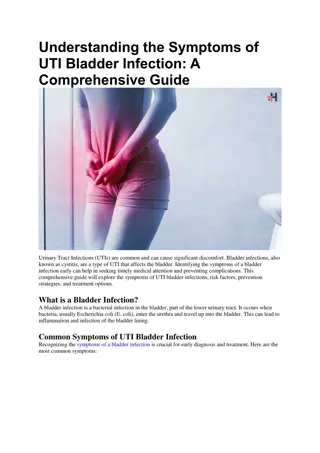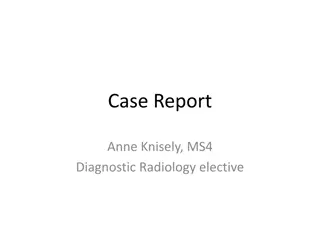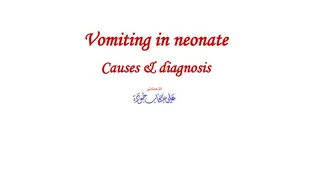
Urinary Tract Infections and Their Classification
Explore the details of urinary tract infections (UTIs), including the components of the urinary system, common infections, differences between male and female systems, and the classification of UTIs into lower and upper types. Learn about the causes, symptoms, and types of UTIs to enhance your knowledge of this common health condition.
Download Presentation

Please find below an Image/Link to download the presentation.
The content on the website is provided AS IS for your information and personal use only. It may not be sold, licensed, or shared on other websites without obtaining consent from the author. If you encounter any issues during the download, it is possible that the publisher has removed the file from their server.
You are allowed to download the files provided on this website for personal or commercial use, subject to the condition that they are used lawfully. All files are the property of their respective owners.
The content on the website is provided AS IS for your information and personal use only. It may not be sold, licensed, or shared on other websites without obtaining consent from the author.
E N D
Presentation Transcript
Urinary Tract Infection Presented by : Abdulaziz Saud Alharbi ID Number : +966599611074
Introduction Introduction: urinary system or renal system is an excretory system of human body, it is useful for eliminate waste, body metabolic balance and also PH etc. it is consisting of kidneys, ureters, bladder, and the urethra,
Function of components Kidneys for filtering of blood, ureters: of transport urine and waste from kidneys to Bladders: store it then transport it to urethra : eject it.
Difference female and male urinary system: Female Urinary System Male Male Longer Away from Anus Urine and Sperm Ejection Female Female Shorter Beside Anus Urination only Distance location Function Because of this difference a female has more chance to have disease than male.
Common infection of urinary system: Common infection of urinary system: Kidney disease which include: 1. 2. 3. 4. 5. glomerulus infection tubules infection medullary interstitium infection general syndromes vascular infection and others Urinary tract infection which include: 1. 2. 3. Ureter Bladder Urethra
Urinary Tract Infection (UTI) I. I. Urinary tract infection is an infection of any part in the urinary system, And it is separate to 2 types lower UTI and upper UTI. lower UTI lower UTI 1. cystitis which infection bladder, 2. prostatitis which infection of prostate and 3. urethritis which infection of urethra. upper UTI upper UTI pyelonephritis (Pain in the loin) which infection of kidney and it s can cause acute renal failure, and also hematogenous. upper UTI more serious than lower UTI. upper UTI more serious than lower UTI. II. II.
Urinary Tract Infection (UTI) continuo. Classification Classification: I. I. Uncomplicated Uncomplicated: function and structure renal tract are normal which caused by E. coli and other gram-negative bacilli (Proteus, Enterobacter, Klebsiella and Pseudomonas) II. II. Complicated Complicated: renal function is decreased based on investigation, symptoms and potentially accompanied by abnormal urinary tract which caused by Proteus, Klebsiella, Pseudomonas Serratia and Enterococcus fecalis.
Epidemiology of UTI. Epidemiology of UTI.
Epidemiology of UTI. Epidemiology of UTI. Most common bacterial infections are urinary tract infections,(1) around 150 million people each year getting affected worldwide, 10% of women getting an infection yearly and more than 40 60% having an infection at some point in their lives.(12) In Saudi Arabia : In Saudi Arabia : microbiology laboratory of Military Hospital at Al-Kharj, in the central province of Saudi Arabia received 1076 urine specimens, 840 females and 236 males between October, 2011 and December, 2011. All the specimens were processed in the Microbiology Laboratory of College of Applied Medical Sciences, Salman bin Abdul Aziz University, Al-Kharj. Of the 1076 specimens, 114 (10.6%) showed positive urine culture. Among those who gave a urine sample for culture a slightly higher proportion of females ; 60 (52.6%) had a positive urine culture as compared with males 54 (47.4%).
Mode of transmission: Mode of transmission: Ascending from perineum Transmission of cystitis is therefore via the environment. Acute bacterial prostatitis may be caused by ascending infection through the urethra. Patients who has nursing home with indwelling urethral catheters may also be at increased risk of acute bacterial prostatitis. Sclerotherapy for rectal prolapse may also increase risk. (6)
Risk factor Women are more likely to develop urinary tract infections (UTIs) than men o urinary catheter. o Immunocompromised patient o Menopause o Predisposition of UTI Predisposition of UTI Menopause and diabetes Pregnancy and catheter. Immunocompromised and kidney problem patient.
Sign and symptoms Sign and symptoms 1. Strong and continuous desire to urination 2. Feel burning when urinating 3. Passing small and frequency amounts of urine 4. Urine appears cloudy 5. Urine appears bright pink or red which mean blood in the urine 6. Smell of urine is strong. 7. Pelvic pain, in women especially in the center of the pelvis and around the area of the pubic bone.(8)
Complication Complication repeated infections, especially in women who infected two or more UTIs in a six- month period or four or more within a year. Pyelonephritis, which is permanent kidney damage from an acute or chronic kidney infection due to an untreated UTI. Increased risk in pregnant women of delivering low birth weight or premature infants. Urethral narrowing (stricture) in men from recurrent urethritis, previously seen with gonococcal urethritis. Sepsis, it is may lead to life-threatening complication of an infection, and increase the opportunity if the infection go up on urinary tract to the kidneys.(9)
Laboratory investigation Laboratory investigation 1. 2. 3. 1. Sample collection: Sample collection: Before antibiotic. Clean area. Use clean-catch midstream technique Analyzing of UTI Analyzing of UTI Checking and recording the color, turbidity (cloudiness), and specific gravity (a measure of how concentrated the urine is) of the sample. Chemical analysis using auto-machine or manually by multi-test dipstick. Centrifuging a small portion of the sample and examining the sediment (heavier particles) under a microscope. 2. 3.
Recent advances Recent advances Recurrent urinary tract infection (UTI) is one of the most common problems in urological clinics. Recent research has revealed novel evidence about recurrent UTI and it should be considered a different disease from the first infection. The pathogenesis of recurrent UTI might include two mechanisms, bacterial factors and deficiencies in host defense. Bacterial survival in the urinary bladder after antibiotic treatment and progression to form intracellular bacterial communities might be the most important bacterial factors. In host defense deficiency, a defect in pathogen recognition and urothelial barrier function impairment play the most important roles. the essential risk factors for recurrent infection consider immunodeficiency and urogenital tract anatomical abnormalities. Voiding behavioral factors and dysfunction also increase the risk of recurrent UTI in healthy women. Sexual intercourse and estrogen deficiency in postmenopausal women might have the strongest association with recurrent UTI. Traditional lifestyle factors such as fluid intake and diet are not considered independent risk factors now. Serum and urine biomarkers to predict recurrent UTI from the first infection have also attracted a wide attention recently. Current clinical evidence suggests that serum macrophage colony-stimulating factor and urinary nerve growth factor have potential predictive value for recurrent UTI. Clinical trials have proven the efficacy of the oral immunoactive agent OM-89 for the prevention of UTI. Vaccines for recurrent UTI are recommended by the latest guidelines and are available on the market.(10)
Prevention Prevention Drink plenty of liquids, especially water. Drink cranberry juice Wipe from front to back. Menopausal women should use estrogen vaginal creams to restore vaginal pH. Treatment Treatment Usually Antibiotics Simple infection : Simple infection : Trimethoprim/sulfamethoxazole etc Frequent infections: Frequent infections: Low-dose antibiotics Severe infection: Severe infection: treatment with intravenous antibiotic.
Case A 25 year old Saudi female pregnant 6 months admitted to hospital with high grade fever associated with chills and rigors since 2 days. Fever has been present for past 2 days, high grade with chills and rigors. Fever was relieved by medication. There is history of loin pain Rt side with difficulty in passing urine with some amount of burning. Patient is in her 6 month of her 3rd pregnancy. No history of cough, shortness of breath, palpitation, diarrhea. Not a known diabetic, hypertensive, food or drug allergies. On examination patient well hydrated, Pulse 90/min, BP 120/80 mmHg, RR 24/min, Temperature 39 c. CVS and lung were normal. Uterine height up to the umbilicus, fetal heart sounds + rate 140bpm, mild tenderness in the right loin region. Pelvic examination revealed slightly distended bladder. Laboratory investigation show Hb 9.5g/dl, RBC 3.2 X 106/ l, MCV 67fL, MCH 21 pg, MCHC 29 g/dl. Urine examination showed turbid urine with plenty of pus cells, epithelial casts. Culture revealed Proteus mirabilis positive sensitive to Gentamicin. TORCH profile done in prenatal clinic is negative.
This case of 25y Saudi female on his 6 months of her 3rd pregnancy Shows she have loin pain in right side which because of pyelonephritis which infection of kidney and it s can cause acute renal failure and it is sign of Acute upper tract obstruction and also fever with chills and rigors which mean Hematogenous spread. She feels in difficulty in passing urine with some amount of burning because of UTI infection, Pelvic examination revealed slightly distended bladder because of lower tract obstruction because of UTI. Hb normally in pregnant women is 10-14g/dl but it is here 9.5 so it is decreased RBC normal MCV decreased may from anemia MCH decreased may from anemia MCHC decreased may from anemia With all these result of blood Hb , MCV, MCH and MCHC it is mean she has iron deficiency anemia. Urine examination showed turbid urine with plenty of pus cells, epithelial casts: Turbid because of UTI infection and pus cells mean it has WBC which because of pathogen infection that means the cells are sloughing off the lining that protects the body from urine, because of an infective organism making residence and causing damage, which is Proteus mirabilis. Conclusion: This patient has a UTI infection causing by Proteus mirabilis and it reach to upper urinary tract infection so it is cause severe pain and loin pain, and also has iron deficiency anemia. So, the treatment upper UTI intravenous IV antibiotic until fever is still then go to oral antibiotic.
Reference: Reference: 1.Foxman B. Epidemiology of urinary tract infections: incidence, morbidity, and economic costs. The American journal of medicine. 2002;113(1):5-13. 2.Al-Mijalli SH. Bacterial Uropathogens in Urinary Tract Infection and Antibiotic Susceptibility Pattern in Riyadh Hospital, Saudi Arabia. Cellular & Molecular Medicine: Open access. 2017;3(1). 3.Drolet R, Dee SA. Diseases of the urinary system. Diseases of swine. 2006:959-76. 4.Krieger JN, Dobrindt U, Riley DE, Oswald E. Acute Escherichia coli prostatitis in previously health young men: bacterial virulence factors, antimicrobial resistance, and clinical outcomes. Urology. 2011;77(6):1420-5. 5.Brede CM, Shoskes DA. The etiology and management of acute prostatitis. Nature Reviews Urology. 2011;8(4):207. 6.Feneley M, Kirby R, Parkinson C. Clinico pathological findings simulating prostatic malignancy following sclerotherapy: a diagnostic pitfall. BJU International. 1996;77(1):157-8. 7. Karram M, Siddighi S. Lower urinary tract infection. Ostergards s urogynecology and pelvic floor dysfunction. 2008:148-69. 8.Raheem HAGA. University of Medical Sciences & Technology Faculty of Medical Laboratory Sciences Department of Medical Microbiology Frequency of urinary tract infections among diabetic patients in Khartoum state. 9.BACTERIURIA A. Urinary tract infections during pregnancy. Am Fam Physician. 2000;61(3):713-20. 10.Jhang J-F, Kuo H-C. Recent advances in recurrent urinary tract infection from pathogenesis and biomarkers to prevention. Tzu-Chi Medical Journal. 2017;29(3):131. 11.Jepson RG, Craig JC. Cranberries for preventing urinary tract infections. Cochrane Database Syst Rev. 2008;1(1). 12. Salvatore S, Salvatore S, Cattoni E, Siesto G, Serati M, Sorice P, Torella M (June 2011). "Urinary tract infections in women". European journal of obstetrics, gynecology, and reproductive biology. 156 (2): 131 6. doi:10.1016/j.ejogrb.2011.01.028. PMID 21349630.






















